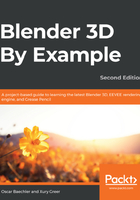
Summary
Wow, that was a lot to take in! We certainly learned a lot about 3D modeling: We learned about several new tools: Spin lets us create radial duplicates around the base of the time machine, while Loop Cut allows us to create new edge loops that support the extrusions we needed for new details throughout the model.
We also learned a new way to use vertex snapping to our advantage when we attached the numbers to the face of the clock. Snapping features are very useful when we need precision in our projects. Then, we learned how to use text objects, which let us add high-quality 3D text to the scene. We also learned about Empty objects, which don't contribute to the final render, but they can give us extra control over things such as the Array modifier's Object Offset parameter. We took a closer look at some of the most common modifiers in Blender, such as the Mirror modifier, the Array modifier, and the Boolean modifier. We learned what these modifiers' extra features do, such as Clipping, Mirror Object, and Object Offset. Getting to know the advanced features in these modifiers opens up a wide range of new possibilities, which is especially versatile when we wish to use several modifiers on a single object. Finally, we added a layer of polish to our model by fixing the shading. Applying a proper mix of flat and smooth shading can really improve the visual quality of a model. Most, if not all, of these techniques will come in handy over and over again when you work on your future Blender projects.
In the next project, we'll learn how to create a complex environment scene. We'll learn how to create lots of assets efficiently and have those assets work together in the most economic way.